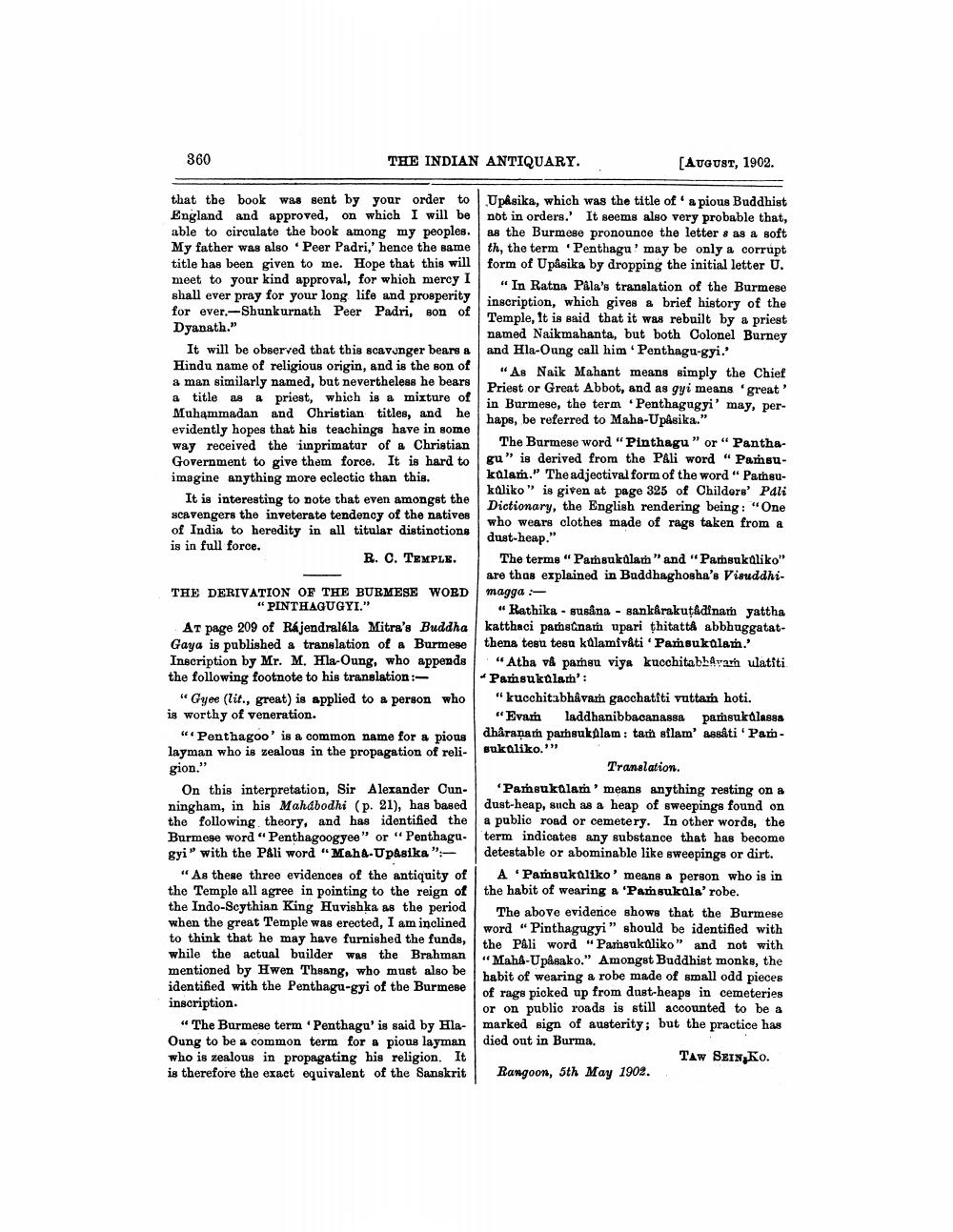________________
360
THE INDIAN ANTIQUARY.
[AUGUST, 1902.
that the book was sent by your order to Upåsika, which was the title of ' a pious Buddhist England and approved, on which I will be not in orders.' It seems also very probable that, able to circulate the book among my peoples as the Burmese pronounce the letter 8 as a soft My father was also Peer Padri,' hence the same th, the term 'Penthagu' may be only a corrupt title has been given to me. Hope that this will form of Upasika by dropping the initial letter U. meet to your kind approval, for which mercy I
"In Ratna Pâla's translation of the Burmese shall ever pray for your long life and prosperity
inscription, which gives a brief history of the for ever.-Shunkurnath Peer Padri, son of
Temple, It is said that it was rebuilt by a priest Dyanath."
named Naikmahanta, but both Colonel Burney It will be observed that this scavenger bears a and Hla-Oung call him Penthagu-gyi.' Hindu name of religious origin, and is the son of
"As Naik Mahant means simply the Chief a man similarly named, but nevertheless he bears
Priest or Great Abbot, and as gyi means 'great' a title as a priest, which is a mixture of
in Burmese, the term "Penthagugyi' may, perMuhammadan and Christian titles, and he
haps, be referred to Maha-Upåsika." evidently hopes that his teachings have in some way received the inprimatur of a Christian The Burmese word "Pinthagu” or “ PanthaGovernment to give them force. It is hard to gu" is derived from the PAli word “Pamsuimagine anything more eclectic than this.
kulam." The adjectival form of the word " Pathsu
koliko" is given at page 325 of Childers' Pali It is interesting to note that even amongst the
Dictionary, the English rendering being : "One Scavengers the inveterate tendency of the natives
who wears clothes made of rags taken from a of India to heredity in all titular distinctions
dust-heap." is in full force.
R. C. TEMPLE. The terms "Pamsukulam" and "Pameukoliko"
are thas explained in Buddhaghosha's VisuddhiTHE DERIVATION OF THE BURMESE WORD magga "PINTHAGUGYI."
"Rathika - susana - Bank&rakutadinam yattha Ar page 209 of Rajendralála Mitra's Buddha katthaci pansanam upari thitattá abbhuggatatGaya is published a translation of a Burmese thena tesu teen kulamivåti 'Pamsukalan.' Inscription by Mr. M. Hla-Oung, who appends "Atba vâ pameu viya kucchitabhavan ulatiti the following footnote to his translation:
Pamsukulam': "Gyee (lit., great) is applied to a person who "kucchitabhâvam gacchatiti vuttam hoti. is worthy of veneration.
"Evam laddhanibbacanassa pansukalassa “Penthagoo' is a common name for a pious
dharanam pathgukülam: tam silam' assåti 'Pamlayman who is zealous in the propagation of reli- sukaliko."" gion."
Translation. On this interpretation, Sir Alexander Cun- Pamsukulam' means anything resting on a ningham, in his Mahabodhi (p. 21), has based dust-heap, such as a heap of sweepings found on the following theory, and has identified the a public road or cemetery. In other words, the Burmese word "Penthagoogyee" or "Penthagu- term indicates any substance that has become gyi" with the PAli word "Mah-Upasika": detestable or abominable like sweepings or dirt.
"As these three evidences of the antiquity of A Pańsukoliko' means a person who is in the Temple all agree in pointing to the reign of the habit of wearing a 'Pamsukula'robe. the Indo-Scythian King Huvishka as the period The above evidence shows that the Burmese when the great Temple was erected, I am inclined
word " Pinthagugyi” should be identified with to think that he may have furnished the funds,
the Pali word "Pamsukuliko" and not with while the actual builder was the Brahman
"MahA-Upåsako." Amongst Buddhist monks, the mentioned by Hwen Theang, who must also be
habit of wearing a robe made of small odd pieces identified with the Penthagu-gyi of the Burmese
of rage picked up from dust-heape in cemeteries inscription.
or on public roads is still accounted to be a “The Burmese term Penthagu' is said by Hla- marked sign of austerity; but the practice has Oung to be a common term for a pious layman died out in Burma. who is zealous in propagating his religion. It
TAW SEIN KO. is therefore the exact equivalent of the Sanskrit Rangoon, 5th May 1902.




